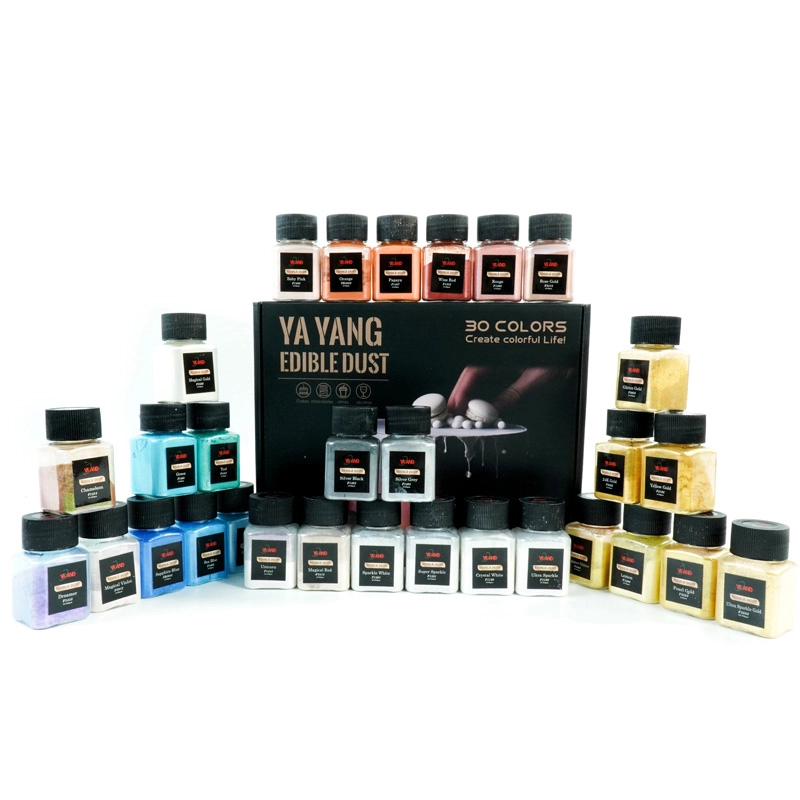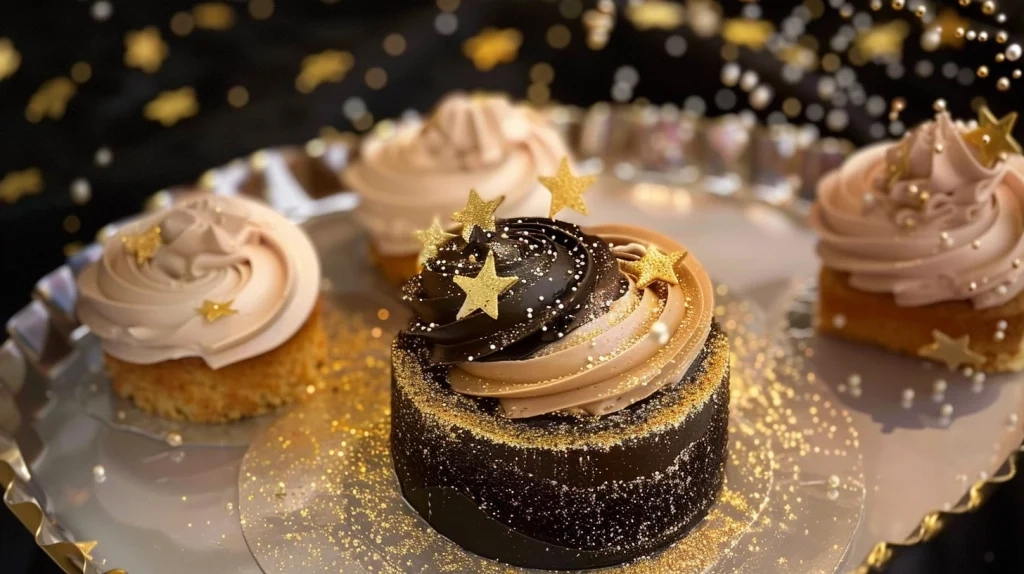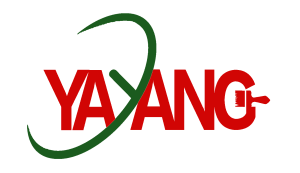
What Are Edible Glitter and Luster Dust?
Defining Edible Glitter: Composition and Uses
Yo, edible glitter is like the sparkly MVP for jazzing up your bakes, candies, and drinks! It’s made to add mad shine to food, using stuff safe to munch like sugar, gum arabic, or starchy bits. Not like that craft glitter made of plastic or metal—that’s a no-go for eating. Edible glitter? Totally food-safe and comes in all kinda colors and sizes. Sprinkle it on cakes, cookies, cupcakes, or toss it in drinks for a shimmery vibe.
It’s a total hit for festive bakes or themed parties where you want eyes popping. Doesn’t mess with flavor or crunch—just pure, sparkly flex.
Defining Luster Dust: Ingredients and Applications
Luster dust is another food-safe powder that’s all about fancy vibes for cake decorating and gourmet goodies. It’s got mica-based pearlescent pigments mixed with approved color additives.

Edible Luster Dust Colors: Silver White, Gold, Iridescent, Copper, Vivid…
Sizes: 5-25um, 10-60um, 30-150um, 40-200um, 50-500um, 70-700um, 200-1000um… Ingredients: E555, E171, E172, E102, E110, E127, E129, E133…
Application: YAYANG’s edible luster dust brings straight-up magic to your sweets! Using edible luster dust for cake decorating, drinks, cookies, and chocolate vibes. Brush it dry for a soft glow or mix with booze like vodka or lemon extract for a paint-like vibe to nail detailed accents.
Perfect for leveling up fondant cakes, chocolate truffles, sugar flowers, or even cocktail rims.
Key Differences in Form, Texture, and Appearance
Edible glitter and luster dust? They’re different beasts. Glitter’s chunkier, like sparkly confetti that catches light like whoa. Luster dust is finer, giving a silky, metallic glow or satin sheen instead of bold bling.
Texture? Glitter’s grainy ‘cause of bigger bits. Luster dust feels smooth like fairy dust with its tiny pigments. Glitter’s sprinkled on; luster dust needs brushing or mixing for that pro look.
Comparing Edible Glitter and Luster Dust in Cake Decoration
Visual Effects on Cakes and Desserts
Edible glitter’s your go-to for big, shiny vibes—think birthdays or holiday bakes that scream “look at me!” It’s perfect for cupcakes stealing the show on a party table.
Luster dust? That’s for fancy, subtle flex. Its pearlescent glow adds class to flower petals or fondant figures without going overboard. The edible dust luster makes stuff pop with vibrant, safe-to-eat shine.
Application Techniques for Different Surfaces
For smooth vibes like fondant or royal icing:
- Brush luster dust dry for soft highlights.
- Mix with alcohol (like vodka) to paint metallic swag.
For textured stuff like buttercream:
- Sprinkle edible glitter before it sets.
- Use tweezers to press into grooves if you’re feeling extra.
On chocolates (needing oil-soluble pigments), skip water-based stuff—go for oil-compatible colorants.
Suitable Types of Decorations for Each Product
Edible Glitter shines on:
- Cupcakes
- Cookies
- Cake pops
- Drink toppers (think shimmery floats)
Luster Dust kills it for:
- Sugar flowers
- Fondant figurines
- Macaron shells (with water-soluble shimmer)
- Chocolate accents (using oil-compatible picks)
Safety and Regulatory Considerations
Understanding Food-Grade Standards
Not every shiny powder’s safe to chow down on. It’s gotta meet food-grade standards from big shots like the FDA (U.S.) or EFSA (Europe). That means every bit’s gotta be cleared for munching, not just “non-toxic.”
Shelf Life: 5 years if you stash it in sealed containers in a cool, dry, dark spot. Keeps it safe and fresh.
How to Spot Real Edible Products vs. Non-Toxic Fakes
“Non-toxic” ain’t “edible.” Craft glitters might say non-toxic but aren’t for eating. Always peep the label—true edible glitter and luster dust list food-safe stuff like mica with titanium dioxide (E171) or iron oxides (E172).
If there’s no ingredient list? Probably just for show cakes, not your tummy.
Labeling Requirements and Consumer Awareness
Good labels gotta have:
- Full ingredient rundown
- Food additive codes (like E-numbers)
- Clear “edible” vs. “non-toxic” callout
Bakers, read those labels like your life depends on it. And let your clients know what’s safe to eat versus what’s just for looks.
Choosing the Right Product for Your Project
When to Use Edible Glitter for Maximum Impact
Go for edible glitter when you want max sparkle that screams party vibes—think unicorn cakes or New Year’s cupcakes where bold’s the goal. It’s clutch on whipped toppings where light hits from all angles for that dazzle.
When Luster Dust is the Preferred Choice
Pick luster dust for fancy, detailed work—like painting gold trim on fondant ribbons or shading sugar roses to look legit. Its versatility’s fire for stuff like cocktail rim bling or airbrushing big cake tiers.
YAYANG’s Expertise in Edible Glitter and Luster Dust Manufacturing
Overview of YAYANG’s Food-Grade Pigment Capabilities
Hangzhou Yayang Industrial Co., Ltd. is slaying the game with:
- Edible Luster Dust
- E171-Free Edible Dust
- Food Coloring Liquid
- Edible Shimmer Sugar Syrup
- Shimmer Effervescent Tablet
- Edible Glue
These show YAYANG’s deep know-how in food-safe pigments for bakers and gourmet pros—not just crafty vibes.
Quality Control and Compliance with International Standards
YAYANG’s all about tight quality control—from grabbing raw materials to packing the final goods. They nail global safety rules with traceable ingredients and batch testing certs.
Shelf Life: 5 years if stored sealed in a cool, dry, dark place. Perfect for pro kitchens juggling stock.
Customization Options for Cake Decorators and Bakeries
YAYANG’s Customization Service lets you craft pigments for specific shades or sizes to match your unique cake vibes. It’s a game-changer for bespoke bakes.
Tips for Applying Edible Glitter and Luster Dust Effectively
Tools and Techniques for Professional Results
For pro-level sparkle:
- Use soft brushes just for food stuff.
- Skip humid spots—clumping’s a buzzkill.
- Layer slow, don’t dump it all at once.
Painting with luster dust + alcohol? Let each coat dry to dodge streaks.
Storage, Handling, and Shelf Life Considerations
Keep powders sealed tight after use. Stash them away from sun in cool spots to lock in that shine. Shelf Life: 5 years in sealed containers in a cool, dry, dark place.
Don’t double-dip brushes in mixed mediums—keeps contamination out, especially if water sneaks in.
Common Mistakes to Avoid During Application
Don’t mess up like:
- Dumping too much product—clumps galore.
- Using water-based colorants on chocolate—it hates moisture.
- Mixing up craft glitter with edible stuff.
- Storing near heat—kills pigment vibes early.
- Not testing colors first—shades can act wild on different bases.
Frequently Asked Questions
- What’s the diff between edible glitter and luster dust?
Glitter’s got big, bold sparkly bits for in-your-face shine. Luster dust’s fine, giving a silky glow for fancy details. - Can I mix them up together?
Heck yeah! Pros use glitter for borders and luster dust for flower pops—total combo vibes. - Are they safe to eat if I scarf them?
If they’re labeled “edible” with clear ingredients, you’re golden. Skip anything just tagged “non-toxic.” - Can I toss them in drinks?
Yup! Using edible luster dust for drinks works if it dissolves clean without messing taste or texture.
To peep how YAYANG’s pigments can level up your bakes safely—and with mad style—hit them up! Hangzhou Yayang Industrial Co., Ltd.’s been a pro at effect pigments since 1999, dropping Pearl Pigment (Food, Cosmetic, Industrial Grades), Glitter Powder, Neon/Luminous Pigments, Metallic Powders, and Thermochromic/Photochromic stuff. Your one-stop shop for bling!
